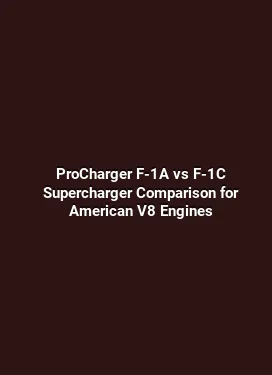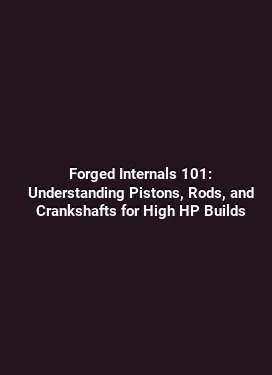Turbo Coolant Lines Installation Guide for Subaru BRZ FA20 Engine
Overview and Purpose of Upgraded Turbo Coolant Lines

For turbocharged Subaru BRZ models powered by the FA20 engine, effective cooling is a critical factor in maintaining performance and longevity. Turbocharger performance hinges not only on air flow and fuel delivery but also on how efficiently coolant circulates around the turbocharger and associated piping. Upgraded turbo coolant lines are designed to reduce thermal soak, minimize back-pressure related heat buildup, and help stabilize oil and coolant temperatures during aggressive driving, hot-lapping, or track sessions. As a practical upgrade, these lines can contribute to more consistent boost behavior and reduce the risk of heat-related detonation in demanding conditions.
Understanding the cooling pathway begins at the turbocharger exit and follows through the intercooler system, radiator, and thermostat assembly. The upgraded lines typically use reinforced hoses or braided stainless steel constructions with higher temperature ratings, improved bend radii, and fewer potential leak points. The goal is to deliver coolant to the critical hot zones with minimal resistance while preserving reliability under vibration and high engine load. This guide outlines a comprehensive approach to selecting components, preparing the vehicle, performing the installation, and verifying system integrity after the work is complete.
Component Selection: What to Look For
Choosing the right coolant line kit is essential for compatibility and performance. For the FA20 engine in the BRZ, consider the following factors when evaluating options. First, verify fitment for the exact generation and model year, as variations in the engine bay layout can affect hose routing and connector sizing. Second, evaluate material quality: braided stainless steel lines offer excellent heat resistance and abrasion protection, while rubber lines with heat-resistant sleeves can provide cost-effective reliability for street use. Third, examine connector types and clamp styles. Quick-connect fittings or heat-resistant barbs should not leak under boost pressure or high-temperature cycling. Finally, ensure that the kit includes all necessary banjo bolts, o-rings, mounting hardware, and a detailed installation guide tailored to the FA20 layout.
In addition to the primary lines, consider supplementary parts that can improve overall cooling performance. An upgraded water pump drive belt or a higher-capacity thermostat can work in concert with new lines to sustain lower coolant temperatures during hard driving. If the vehicle has a larger intercooler or intake system, verify that hose routing accommodates the additional demand without kinking or stretching under engine movement. Always cross-check the compatibility of any auxiliary components with the BRZ’s original cooling system to avoid interference with fans, shrouds, or sensor housings.
Tools and Preparation: Laying the Groundwork
Proper preparation reduces installation time and helps ensure a clean, leak-free result. Begin by disconnecting the battery to mitigate any electrical shorts while working near sensor connections and metal fittings. Drain the coolant from the radiator and engine block into a suitable container, following the FA20’s service guidelines to avoid oil or coolant mixing. It is important to capture and recycle used coolant in environmentally responsible fashion. With the cooling system depressurized, inspect the current routing of the stock lines to understand how the new components will interface with OEM clamps and brackets.
Next, gather essential tools: metric wrenches and sockets (typically 8mm, 10mm, 12mm, and 14mm), pliers, a hose clamp crimping tool or screwdriver, thread sealant or PTFE-based tape if required, a torque wrench to specification, and a container for temporary coolant catch. Having a torque spec sheet on hand helps prevent overtightening, which could damage fittings. A large towel or absorbent mat is useful for catching small spills and protecting the engine bay from coolant residue. Finally, keep a good quality coolant compatible with the FA20 system within reach, as you will need to top off the system after successful bleeding and leak checks.
Disassembly: Accessing the Turbo and Related Lines
Accessing the turbo coolant lines requires careful disassembly of surrounding components without forcing bolts or disturbing neighboring sensor wires. Start by removing the engine cover if present, followed by the upper intake ducting to gain visibility of the cold side and the turbocharger inlet. Identify the stock coolant lines that feed the turbo housing and the intercooler, noting their routing and connection points. Practically, you may need to loosen or relocate the intercooler pipe or associated brackets to create enough clearance for the new lines.
When removing hoses, use a steady, gentle operation to avoid damaging plastic quick-connects or metal fittings. If a line is stubborn, apply a small amount of penetrating oil and work it free after several minutes. Keep track of all hardware and components, labeling them if necessary to simplify reassembly. Inspect the mating surfaces for nicks or burrs, as rough edges can compromise sealing rings and create leaks after installation. If any mounting brackets show signs of fatigue, replace them with OEM or high-quality aftermarket equivalents designed to withstand engine vibrations and temperature cycling.
Preparation and Tools for Disconnecting and Re-routing

Before loosening clamps, visually map out the new route for the upgraded lines. Plan to minimize sharp bends and ensure ample clearance from belts, pulleys, and the exhaust manifold heat shield. Use stiffening rods or wooden dowels to guide hoses into place without kinking them. When disconnecting fittings, always cap open ends to prevent debris from entering the cooling circuit. After removing the stock lines, compare them to the new kit’s length and connector geometry to verify compatibility, and note any extra hardware that may require retention or relocation.
Installation: Routing and Connecting the Turbo Coolant Lines
begin with cleaning the connection ports on the turbocharger housing and the corresponding coolant elbows. Dry fit the new lines to ensure proper fitment before applying any sealant or clamps. If the kit includes heat sleeves or protective wraps, install these components to reduce the risk of abrasion from vibration or routing near hot surfaces. When attaching lines, verify that each connector seats fully with a tactile click or a firm snug fit, and then secure with clamps in a uniform gradient to avoid stress points.
For rubber-to-metal transitions, ensure that an appropriate O-ring or seal is seated correctly to prevent coolant leaks. If the kit uses banjo fittings, replace washers and ensure they are clean and free from debris before reassembly. After routing all lines, double-check that there are no interference points with the throttle body, fuel rails, or electrical connectors. A practical tip is to gently move the engine bay components by hand to simulate normal operation, ensuring there are no contact points that could cause chafing at full travel of the engine or during cornering loads.
Bleeding and Filling the Cooling System
Bleeding the cooling system after installing upgraded lines is essential to remove air pockets that can cause hot spots and inaccurate temperature readings. Start by filling the radiator to the recommended level, then gradually add coolant through the expansion tank as the system cycles. Start the engine and allow it to reach operating temperature with the heater set to hot. This step helps purge trapped air from the coolant pathways, including the turbo feed lines. Watch the temperature gauge and listen for unusual sounds that could indicate air pockets or leaks.
With the engine running, check for leaks at all hose connections and fittings. If air pockets persist, you may need to perform an additional bleed cycle or run the engine with the radiator cap loose briefly to encourage air to escape. Replace the cap once the thermostat opens and a steady flow of coolant is observed. After the system stabilizes, re-check the coolant level and top off as necessary. A thorough coolant purge not only protects the turbo but also extends the life of the entire cooling matrix by maintaining consistent operating temperatures during high-demand scenarios.
Testing Under Real-World Conditions
To verify the effectiveness of the upgrade, conduct a controlled test drive focusing on sustained high-load conditions such as highway pulls and spirited canyon runs. Monitor coolant and oil temperatures, adjusting driving style to avoid thermal overload during the early phase of testing. The upgraded lines should show lower peak temperatures and quicker recovery after high-temperature episodes. If temperature spikes persist, recheck the line routing, clamps, and seal integrity. It may be necessary to re-inspect the mounts for any movement that could loosen connections or create micro-leaks over time.
In addition to temperature metrics, pay attention to the overall system pressure and ensure that there are no abnormal pressure fluctuations, which could point to a restriction or improper bleed. Document the readings and compare them to baseline measurements from before the upgrade to quantify the benefits. Regular inspection intervals after installation—such as 500 miles, 1,000 miles, and after any high-stress track events—help maintain long-term reliability and identify wear patterns early.
Maintenance and Longevity: Keeping the System Healthy
Maintenance for turbo coolant lines focuses on cleanliness, secure connections, and monitoring for signs of wear. Periodic inspection of line surfaces for cracks or abrasions, especially near bend zones and clamps, is essential. Replace any line or clamp showing signs of deterioration or corrosion. Use high-quality coolant and ensure compatibility with the BRZ’s cooling system to avoid seal degradation and mineral buildup. If the vehicle spends significant time in hot climates or experiences frequent track use, consider more frequent inspections and a higher grade of coolant with improved heat transfer properties.
Proper storage and installation documentation aid future maintenance. Keep a service log noting part numbers, installation dates, and any anomalies observed during testing. When reassembling after service intervals, re-check torque values on all clamps and mounting hardware to maintain tight, leak-free joints. A methodical approach to maintenance reduces the likelihood of heat-related issues and ensures the upgrade continues to perform under demanding driving conditions.
Real-World Benefits and Practical Tips
Upgrading turbo coolant lines in the FA20 BRZ can yield tangible benefits beyond thermal management. Improved line rigidity reduces the risk of hose collapse under boost, contributing to more stable turbo response. The enhanced routing minimizes the chance of hose interference with moving components, which is critical for reliability during daily driving and weekend track events. In practical terms, drivers may notice smoother boost curves, more consistent throttle response after sustained acceleration, and a lower likelihood of overheating in hot weather or during aggressive driving sessions.
As a practical tip, align the routed lines along existing OEM brackets where possible to minimize vibration-induced wear. Avoid routing lines across the hottest exhaust components or near sharp edges, which can accelerate material fatigue. Keep the lines away from the radiator fan shroud to ensure unobstructed airflow and reduce noise. With careful planning and attention to detail, the upgrade can deliver performance gains without introducing new failure points.
Summary of Key Steps
Successful installation of turbo coolant lines involves thoughtful component selection, careful preparation, precise disassembly and re-routing, meticulous bleeding and filling, thorough testing, and disciplined maintenance. Each step builds toward a reliable cooling solution that complements the FA20-powered BRZ’s performance envelope. By understanding routing, ensuring seal integrity, and validating system pressure and temperatures through controlled testing, owners can achieve a robust upgrade that supports sustained performance gains across a broad range of driving scenarios.






